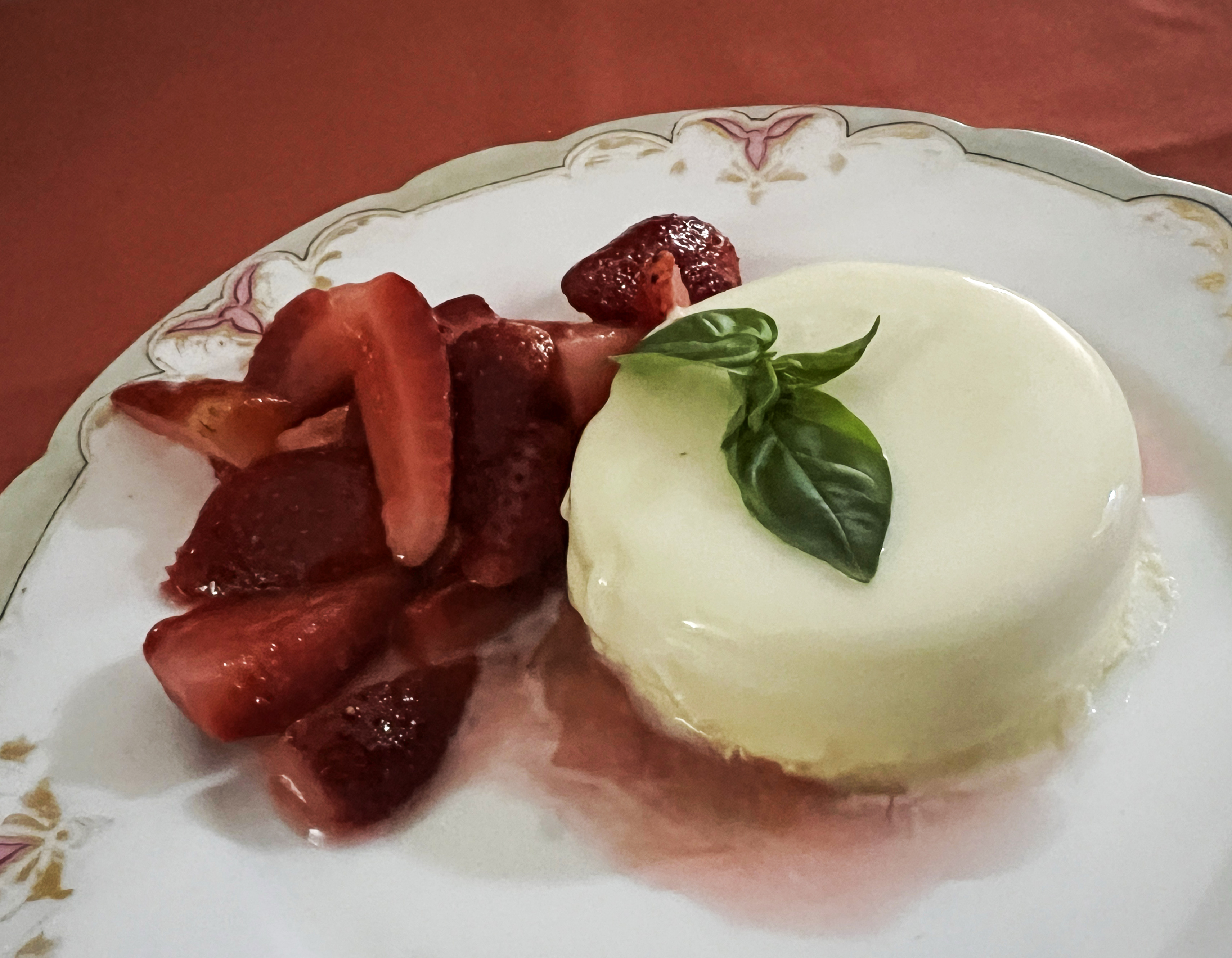If a grown-up hankers after a cold dessert to remind them of the jelly of their youth, but spruced up for the adult palate, panna cotta is the logical answer. It has that set jelly wobble, but it is creamy too, and with few exceptions has a subtler flavour than the fruity jellies of childhood.
“Look at that wobble” has become the near-comical cliché uttered by almost anyone who is presented with a panna cotta and has immediately given the plate a little shake. Never mind that it’s the eating that literally is the proof of the pudding. It needs to be dreamily smooth, with no grainy texture whatsoever. I don’t know about you, but that little shake and tired old remark has me rolling my eyes. Anyway.
Many sources cite “a Hungarian lady” from a village in the Langhe area of Piedmont in the early 1800s as the first to have made a panna cotta, though the lack of a name casts this in doubt. But Piedmontese do list it as a traditional dish of the region, so there must be fair evidence for this.
It reached fame in the 1960s when chef Ettore Songia put it on the menu of his i tre citroni restaurant in Cuneo, Piedmont. It is sometimes compared with various other European cold puddings, such as the French blancmange and Bavarian cream.
It has been likened to latte inglese (English milk), although there is egg yolk in that and not in panna cotta, which comprises only cream (and often milk), sugar and gelatin, with an additional flavourant. The last could be vanilla, or chocolate, or coffee, or a liquor such as rum or marsala. Because there is no egg in panna cotta, it is not a custard.
I decided that there was nothing to stop me from making pink gin panna cotta, having been sent a bottle of Musgrave rose-water-infused pink gin, which sat on the liquor cabinet for some weeks while I puzzled about what to do with it; it’s not something I drink, and anyway, the point for me is to cook with such ingredients that occasionally come my way.
Enjoy Tony Jackman’s writing and way with food? Sign up to Tony’s weekly newsletter here. It’s free, and in your inbox every Friday afternoon. If it goes to promotions or spam at first, please drag it into your inbox.
I also found some lovely ripe Gqeberha strawberries at my local store and decided to macerate those in the pink gin as well. The product has an unmistakable rose flavour and would be a wow in a cocktail, and best not muddled with all sorts of other flavours. The rose needs to shine through and almost any other flavour would mask it. I would go with gin and vodka, and perhaps a drop of rose water, available at chemists and at Indian and Cape Malay spice stores.
The combination of the panna cotta with rose-water-pink-gin-infused strawberries was a winner; I think you’ll like it. Substitute other berries as they come into season in the coming months.
Rose water pink gin panna cotta with macerated strawberries
(Serves 4)
Ingredients
3 tsp gelatin
250ml thick cream
250ml full cream milk
30g castor sugar
3 Tbsp Musgrave rose-water-infused pink gin
A pinch of salt
Basil for garnish
Cooking oil spray to grease 4 ramekins
Pink gin strawberries
500g strawberries, hulled and quartered
2 Tbsp castor sugar
4 Tbsp Musgrave rose-water-infused pink gin
Method
Spray 4 ramekins with cooking oil spray.
Pour the milk into a saucepan and sprinkle the gelatin on top. Leave it for 5 minutes for the gelatin to bloom. It will wrinkle.
On a low heat, warm the milk very gently, being absolutely certain that it will not come close to boiling. Stir or whisk gently but constantly while the gelatin melts into the milk. You cannot leave it to go and do something else in the kitchen. When steam rises, immediately take it off the heat.
Add the sugar and put it back on the heat, stirring while it dissolves. Again, do not boil. Remove from the heat.
Whisk in the cream and the pink gin and a tiny pinch of salt.
Pour equally between the 4 ramekins.
Refrigerate for about 4 hours or longer.
For the macerated strawberries:
Cut the hulls off the strawberries and discard. Slice each strawberry into 4 and put them in a bowl. Add castor sugar and pink gin and stir. Refrigerate, stirring once an hour until it’s time to serve them alongside the panna cotta.
Pour very hot water into a container. Dip each ramekin in it for 5 seconds. Put a small plate on top of the ramekin and deftly turn it over. If it does not fall onto the plate, repeat. In a worse case scenario, eat it out of the ramekin with a teaspoon (as anyone who has ever made panna cotta has done at least once). However, mine did release first time. Serve the strawberries alongside.
Garnish with fresh basil. DM
Tony Jackman is Galliova Food Writer 2023, jointly with TGIFood columnist Anna Trapido. Order his book, foodSTUFF, here
Follow Tony Jackman on Instagram @tony_jackman_cooks.





